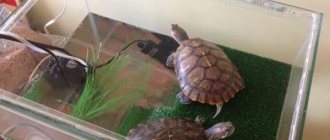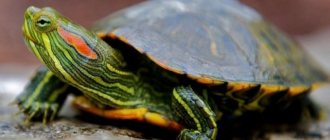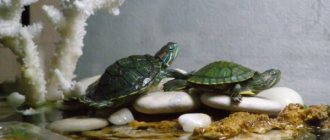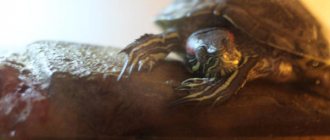This question worries many who have decided to have an animal at home, but simply answering it is not so easy.
To determine the sex of a red-eared slider, you need to wait until it reaches a certain age, when a number of signs begin to indicate its gender. Having reached the age of 6-8 years, the red-eared slider is ready to breed. It is during this period that it is easiest to determine their sex, but already at 1.5-2 years, after analyzing all the combined characteristics, you can try to determine the sex of the red-eared slider. In order to determine gender, you should pay attention to the following features that can distinguish a boy turtle from a girl turtle.
Claw length
Male red-eared sliders have longer claws on their front feet than females. The male needs this in order to hold onto the female’s shell more firmly at the time of fertilization. Females have slightly shorter claws, but they are more blunt.
This method is quite simple, but can be misleading in the process of keeping them in captivity. Spending a lot of time on the island, the turtle can wear its claws. Here everything will depend on what material the sushi element is made of.
Diseases of aquatic reptiles and preventive measures
If you provide the marsh turtle with decent living conditions, you can avoid any problems with its health. She has strong natural immunity and high vitality. Most turtle illnesses are associated with improper housing conditions or poor care. More often than others, the following diseases and pathologies are detected in freshwater reptiles:
- A cold is the result of cooling or keeping your pet in a draft. It manifests itself in the form of irregular, difficult breathing, the appearance of mucous discharge from the nasal passages and oral cavity. The turtle begins to wheeze, refuses to eat, and moves little.
- Rectal prolapse or prolapse of the cloaca (cloacitis) - pathology can occur due to various reasons. Most often it develops against the background of helminthic infestation or prolonged diarrhea. The turtle's cloaca is visible, soil and debris stick to it, and the front limbs may swell.
- Diarrhea - in most cases, is the result of eating low-quality or stale food.
- Nematodosis and cestodosis - tapeworms and roundworms enter the reptile's body from food that has not undergone heat treatment.
- Intestinal obstruction - the main cause is associated with the ingestion of foreign objects - small pebbles, sand, debris. Rarely manifests itself in the form of vomiting, shortness of breath, and neurological disorders.
- Paralysis of various origins.
- Violation or delay in egg laying - a turtle can carry its offspring beyond term due to a narrowing of the birth canal, large egg size, lack of a ready-made nest, and other reasons.
- Infection with ectoparasites - creatures that parasitize the outer surface of the reptile.
In addition, when home furnishings are violated, residents are often injured and their skin is damaged. Often, inexperienced owners of marsh reptiles make a number of mistakes when keeping their pets, which leads to deformation of the armored scutes. More often, this occurs as a result of a deficiency of vitamin components and calcium during the period of active growth and puberty of the individual.
Features of the shell
By carefully studying the structure of the shell of a red-eared turtle, you can just as easily determine the gender of your pet. In order to facilitate the mating process, males have a shell with a concave abdominal part. Females do not have this feature.
If you look closely at the shape of the shell, it is different: males have a more elongated and elongated shape. In the area of the tail, the shape of the shell of males is similar to the Latin letter V, while in females it is more rounded. In the tail area, the female has a large hole, which facilitates normal egg laying.
Determination of gender
Having bought a funny turtle, many owners think about breeding offspring, and, as a rule, about acquiring a sexual partner for their pet. However, before getting a second animal, you must accurately determine the sex of the red-eared slider, and this is not an easy question.
The easiest way to find out the gender of a pet is at 6–8 years of age, when the turtle shows characteristic signs. However, if you carefully analyze the behavior and appearance, you can determine the sex of the turtle at one or two years.
Red-eared slider - how to determine gender:
- by claw size;
- by shell;
- along the tail and cloaca;
- having studied the characteristics of behavior.
The first way to determine sex is to compare the length and shape of the claws of male and female individuals. Male turtles have claws that are irregularly shaped and long, while female turtles have short claws with a rounded edge. When examining the fingers of your pets, you should take into account that turtles living in captivity have their claws ground down on the ground, so this method is not infallible.
The second method of determination is to examine the shell. To facilitate mating, nature created a more extended and elongated shell shape in boys; the female sex has a more rounded and wider shell.
The most common way to distinguish the sex of a red-eared turtle is to study the tail and cloaca. Having carefully examined the back of the pet, a conclusion is made based on the following statements:
- the male's tail is longer, thick at the base and tapering towards the end;
- girls have a round, short ponytail without narrowing or widening;
- The female's cloaca looks like an asterisk and is located closer to the shell;
- The cloaca of the male individual looks like a line, and is removed from the shell.
Sex determination is also carried out by comparing the sizes of two adult turtles of different sexes. It is important that the turtles are the same age, so in this case you need to know how to determine the age of a red-eared slider. Females are larger and more massive than males, since they bear offspring and lay eggs in the future. Clearly expressed signs of gender differences appear during the mating season - male turtles become more active, behave agilely and try in every possible way to attract the attention of their partner, and female turtles calmly evaluate the behavior of the male.
Other signs of red-eared turtles
If there are turtles of the same age, you can try to determine their sex by their overall dimensions. Females are slightly larger than males because they will have to carry and then lay eggs.
Some experts point out that the male's muzzle has a more elongated shape than the female's muzzle. The female's muzzle has a more round outline. The paws of males have more pronounced spurs, which indicates that they are stronger than the paws of females.
Relationship between age and red spots
The most likely place to purchase a turtle for a home pond is a pet store, where the seller, among other data, must tell you the age of the reptile being purchased.
However, you, as the future owner, also need to navigate this issue, since reptiles of different ages feed differently and require different care, and having at least basic information about the future pet will be very useful.
So, the red-eared turtle is called due to the presence of red spots behind its eyes, which, in general, are in no way connected with the hearing organs.
Over the course of a turtle's life, as it grows, these spots change their color saturation from scarlet to burgundy.
The green carapace of the red-eared reptile with stains and stripes at a younger age becomes darker and duller as it ages.
An important indication of the age of a red-eared turtle can be the size of its carapace. But here it should be taken into account that in comfortable conditions a pet can grow at an accelerated pace, and there are many subspecies of red-eared reptiles, and not all of them have the same shell length/age ratio.
So how can you determine the age of your red-eared pet as reliably as possible?
The most accessible to a non-specialist for determining the age of red-eared reptiles are several methods - by the length of the carapace and the pattern on it, by its color and shape.
Features of behavior
It is especially possible to determine the sex of red-eared turtles during the mating season. Behavioral characteristics indicate that each pet belongs to one gender or the other. During the mating season, the activity of males increases sharply. They organize all sorts of demonstrations to demonstrate their capabilities. At the same time, they actively swing their front legs, with much larger claws than the females have. During this period, they constantly chase females and make attractive head movements.
If someone is seriously involved in breeding red-eared turtles, then this article will be very useful, since at an early stage, before they are ready to reproduce, turtle pairs can be formed. In addition, such knowledge will help to correctly and accurately name pets, which is very important for many owners.
In pursuit of something unusual, it has recently become fashionable to keep exotic animals such as snakes, boa constrictors, chameleons, etc. at home. This list also includes many species of turtles, including the red-eared slider. All of them are representatives of the tropics and require special attention and special conditions of detention. It is very important that all those who want to have a red-eared turtle at home understand that it also needs certain conditions, without which it simply cannot live. In addition, this is a very expensive business, since the turtle’s diet must be varied, otherwise it will not be able to develop normally due to lack of nutrients.
Adviсe
- Sex can be recognized after puberty.
- A reliable option would be to make comparisons across multiple animals. Sometimes some signs are similar in turtles of different sexes. It is better to check pets based on several factors.
- Living conditions in animals sometimes cause hormonal imbalance. Then only a veterinarian can determine the sex.
Previous
InhabitantsGetting rid of food debris using the ampullaria snail
Next
InhabitantsWhat to feed omnivorous and herbivorous land turtles at home?
Differences in the character of males and females
Behavior during the mating season clearly demonstrates the difference in temperament between individuals. If girls are characterized by a calm state and moving within the aquarium only when necessary, then males show aggression. In order to attract the attention of the opposite sex, they begin:
- chase turtles;
- bite females on the neck;
- make a squeak.
The last sign does not provide a guarantee - some girls are capable of imitating this sound, which introduces uncertainty. In childhood, they can imitate flirting with their claws and bite other individuals.
During the mating season, boys begin to actively court and demonstrate their advantages, which looks like a dance: they begin to move their front paws and tail, actively shake their heads in different directions, and try to ride the person they like.
To prove his own strength, the male shows aggression towards his aquarium neighbors, provoking fights. They begin with a flip onto the shell and strikes with the paws. Sometimes there are attempts to bite competitors on parts of the body that are not covered with a hard shell (hind legs, tail, neck), which leads to severe, life-threatening injuries.
A set of accessories for an aquarium for a turtle
To ensure a comfortable stay for your turtle in the aquarium, you need to buy the following accessories:
- the aquarium itself (with a volume of at least 200 liters);
- water heater (rated at 100 watts);
- external filter;
- a special UV lamp for aquatic pets;
- heating lamp;
- small thermometer;
- lamp;
- artificially created island or shore.
Aquarium
After looking at your little miracle and reading our article, you will decide that we were mistaken in the recommended aquarium volumes. Two hundred liters, and this little cutie? No, the requirements are not excessive. The turtle will have to grow and grow - and you won’t have to buy it a new aquarium in a year. The information that if you keep your pet in a small container, you can maintain its miniature size is an outright lie. The animal will grow, one way or another, but it will be sick and crooked.
artificial island
Be sure to provide for the presence of an artificial island or shore. This is where your turtle will regularly crawl (mount it so that it is slightly submerged in water). The surface of the land area should be textured, the rise should be sloping, without sharp corners. Contains only non-toxic materials. The island should occupy at least one fourth of the entire aquarium. Additionally, heating is required so that the temperature on the shore exceeds the water temperature by 10 degrees. It is better not to install the island next to the wall of the terrarium (the pet may get stuck in the crack and get hurt).
Aquarium soil
If you live in the spirit of minimalism, then soil, like other decorative elements, is not necessary. But it significantly enlivens the environment of the red-eared home. Gravel is not suitable (animals can swallow it and die). It is better to use large stones: it is both safe and easier to care for the aquarium.
Heat lamp and thermometer
It’s natural for turtles to go ashore to bask. They need this at home throughout the day. Having purchased a lamp, place it in the center of the island at a distance of 20-40 cm from the reptiles
Attention: close proximity of the lamp can lead to burns to your pet! Place water protection on the surface of the device (when immersed, turtles splash, which can cause an electrical short). Be sure to monitor the temperature data
Aquarium water
Red-eared turtles are aquatic, which means they spend most of their lives in water. The quality of the liquid must be appropriate (they also eat, sleep and go to the toilet in water). As a caring owner, install powerful filters and change the water frequently. The minimum possible level of liquid in the aquarium is determined by the pet’s ability to easily turn over from the “on its back” to the “on its belly” position.
Water changes are carried out 1-2 times a week. A new portion of liquid must first (one day before) settle in an open container so that the chlorine is removed from the water and it becomes room temperature. The optimal water temperature for red-eared turtles in an aquarium is 22-28 degrees.
Water temperatures above 28 degrees and below 20 degrees are harmful to the health of red-eared fish.
Article information
Pets
In other languages:
English: Tell If a Turtle Is Male or Female, Español: saber si una tortuga es hembra o macho, Deutsch: Das Geschlecht einer Schildkröte bestimmen, Português: Saber Se uma Tartaruga É Macho ou Fêmea, Italiano: Capire se una Tartaruga è Maschio o Femmina, Français: déterminer le sexe de votre tortue, 中文: 区分乌龟的性别, Nederlands: Het geslacht van een schildpad vaststellen, 日本語: カメの性別を見分ける, : Čeština: Jak poznat, zda je želva samec či samice, Bahasa Indonesia: Membedakan Jenis Kelamin Kura Kura, Tiếng Việt: Nhận biết Rùa Đực và Rùa Cái, Türkçe: Bir Kaplumbağanın Erkek Veya Dişi Olduğu Nasıl Anlaşılır
This page has been viewed 91,030 times.
Medical research
If after all the manipulations it was still not possible to understand the gender, then you can turn to medical research. This technique can be used only after the ovaries or testes have fully matured.
IMPORTANT! If kept incorrectly, the reptile's hormonal levels are disrupted, which reduces the reliability of the results obtained.
When determining gender use:
To ensure the reliability of the information received, it is important to act step by step. Determining the sex of a red-eared slider should be done using all the proposed methods. If the results obtained are inconsistent and do not allow you to confidently classify your pet as a specific gender, trust your veterinarian.
What to feed your reptile at home
To begin with, it is worth determining which of the three categories the turtle belongs to by type of nutrition, distinguishing it in order to understand what ratio of plant and animal food the animal should receive and what to feed it. List:
To properly feed turtles, you need to study what they eat in nature.
Predatory
80% plant and 20% animal.
- Main food: lean fish, beef or chicken liver (once a week), seafood and small mammals.
- Additional: dry food, insects, shellfish, amphibians and invertebrates.
- Prohibited: meat, fatty fish, milk, cheese, bread, fruit, dog or cat food.
Omnivores
50% plant and 50% animal. Everyone loves to eat.
Main food: for aquatic animals – fish, seafood and algae; for land animals - mice, fruits, vegetables and land plants.
Second way
The reptile's shell represents its unique passport, provided that it was provided with good care, properly fed and provided with enough living space.
In this case, the concentric rings on the carapace will indicate a certain number of years she has lived. These rings first appear on the turtle’s shell when it reaches one year of age, and for the first two years of its life, the grooves of the rings are marked quite dynamically, adding two or three every six months.
To do this most accurately, you need to count the number of rings in different parts of the carapace and display the average result.
Should you pick up a turtle?
Let us remind you that red-eared turtles live at home in an aquarium. When removing an animal from the water, be prepared for it to be slippery. But this is not the main difficulty. The yellow-bellied creature is 100% likely to resist such contact. The turtle will begin to hiss, scratch you with powerful paws with sharp claws, bite, and it is possible that he will attempt to empty his bowels directly into your palm.
So in theory, you can pick up your pet, but is there a need for this tactile contact? If touching cannot be avoided, take the animal with both hands, fix it carefully but firmly, then the turtle will not slip out and you will not be bitten.
After contact, be sure to wash your hands with soap. Make sure that children do this especially. Explain to kids that affection with red-eared cats is unacceptable: these creatures, cute at first glance, can be dangerous, because carry salmonellosis. For this reason, animals should not wander around the kitchen and, especially, the dining table. You should also avoid washing your pet or its aquarium and accessories in the kitchen sink or bathtub.











